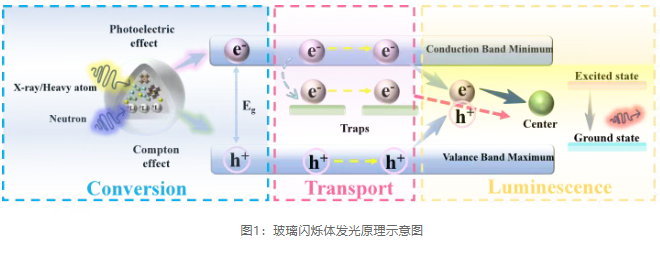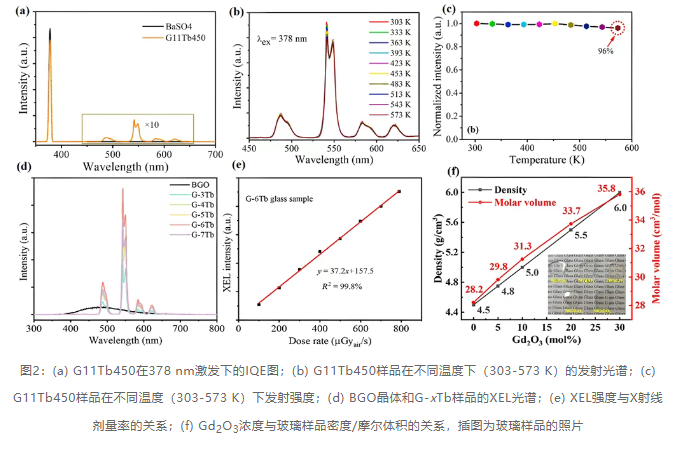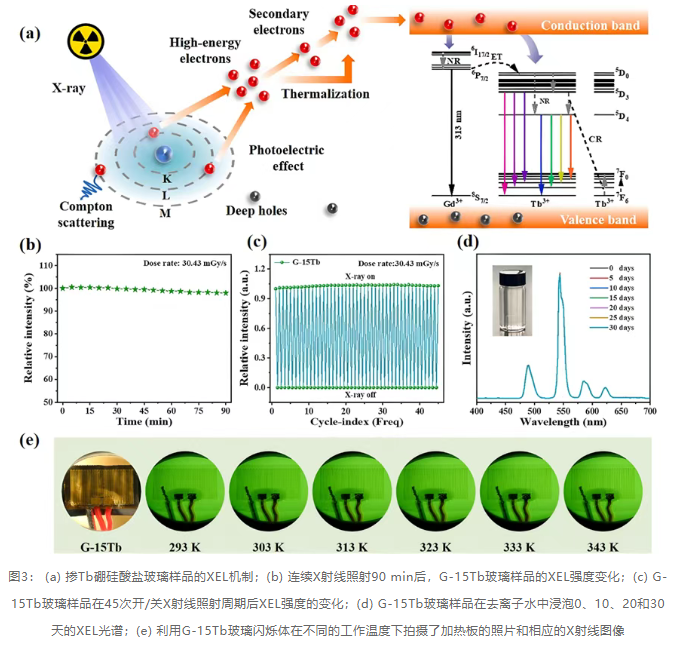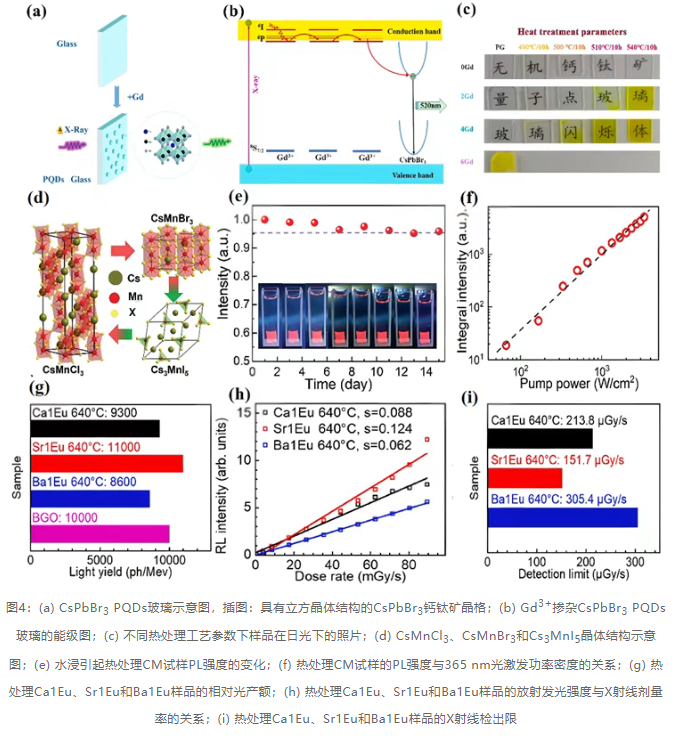15
2025
-
07
Preparation and research progress of glass scintillators for X-ray imaging
Author:
Scintillators have enormous application potential in high-energy physics precision detection, nuclear physics research, medical diagnosis, industrial flaw detection, and national defense security monitoring. However, traditional scintillator single crystal materials have complex preparation processes, high costs, and limited size, making large-scale preparation difficult. In recent years, glass scintillators have stood out due to their highly mature processes, low cost, efficient luminescence, and excellent plasticity. In addition, glass scintillators also have advantages such as simple preparation, adjustable composition, good uniformity, easily controllable morphology and size, and can be processed into optical fibers or fiber plates, further expanding their application scenarios. Recently, Wuhan University of Technology Researcher Xu Yinsheng team published a paper entitled " Research Progress on Glass Scintillators for X-ray Imaging " invited review article in the authoritative journal, which systematically reviews the research progress of glass scintillators for X-ray applications. First, the luminescence mechanism of glass scintillators is elaborated in detail, and the key parameters for evaluating their scintillation performance are listed; second, according to their composition and structural characteristics, they are divided into oxide glass scintillators, halide glass scintillators, and micro/nano-crystalline composite glass scintillators. The latest research results and development trends of glass scintillators for X-ray applications are reviewed, and high-density glass scintillators are summarized. Finally, the current challenges facing glass scintillators are summarized, and the future development prospects are prospected.
As a luminescent material that can convert incident high-energy rays (X-rays, γ-rays) or radiation particles (thermal neutrons, α-rays, β-rays) into ultraviolet or visible light, scintillators can be coupled with photoelectric detectors (such as various photodiodes, photomultiplier tubes, charge-coupled devices, etc.) to detect high-energy particles and ionizing radiation. They have a wide range of applications in nuclear physics, biomedical imaging, industrial non-destructive testing, geological exploration, and national defense security. In recent years, glass scintillators have become a type of scintillator material due to their advantages such as simple preparation, adjustable composition, excellent luminescence performance, and strong radiation resistance. However, existing preparation processes still cannot simultaneously meet the balance of multiple performance indicators such as spatial resolution, light yield, stability, and transparency. Future research can combine advanced methods such as theoretical calculations and simulation to further expand the glass scintillator material system. Key development directions include: developing new matrix materials with high X-ray absorption coefficient, excellent exciton transport efficiency, low phonon energy, and high lanthanide ion solubility, ultimately achieving the research and development and large-scale application of large-size, high-luminescence efficiency, and high-resolution glass scintillators.
Basic Detection Principle of Glass Scintillators
(1) Conversion Process: High-energy X/γ rays, high-energy particles α/β or neutrons, etc., interact with the scintillator, depositing part or all of their energy in the material. The deposited energy generally exists in the material in the form of a large number of electrons and holes generated and thermalized in the valence band and conduction band.
(2) Transport Process: The thermalized secondary electrons and holes are transported to the luminescent centers in the material, and pump the electrons of the luminescent centers from the ground state energy level to the excited state energy level; the migrating charge carriers may be trapped by defects such as ion vacancies and grain boundaries in the scintillator material, or self-trapped in the lattice, resulting in non-radiative loss and delayed radiative recombination. Therefore, it is necessary to suppress these defects by reasonably optimizing the crystal growth process or surface morphology of the scintillator material.
(3) Luminescence Process: Electrons and holes are captured by the luminescent centers during migration, and then release energy through radiative transitions to produce scintillation light. The characteristics of the luminescent center directly determine the emission wavelength, fluorescence lifetime, and afterglow of the scintillation light. In addition, the luminescence efficiency is closely related to the probability of secondary electrons reaching the luminescent center. Therefore, optimizing the distribution, concentration, and local environment of the luminescent center is one of the key factors in improving the performance of glass scintillators.

Research Progress of Glass Scintillators for X-ray Imaging
Oxide glass scintillators can be divided into silicate, borate, aluminate, germanate, antimonate, and phosphate glass scintillators, depending on the glass matrix. Researchers have obtained a series of high-transmittance, excellent luminescence performance scintillating glasses by doping silicate glass. Wang et al. prepared 73.2SiO 2-15.3Na2O-6MgO-2ZnO-3.5CaO-11TbF3 (G11Tb450, mole fraction) glass scintillator, whose XEL intensity is 149.9% of commercial BGO crystals; IQE can reach 97.8%; showing good thermal stability: Figure 2(a)~(c). With B 2 O 3 and SiO 2 as network formers, borosilicate glass has advantages such as high transparency, low thermal expansion coefficient, high rare earth ion solubility, and good radiation resistance. Huang et al. designed a series of Tb 3+ doped borosilicate glass (BSG): 13Al 2 O 3-11B2 O 3-46SiO2-20Na2O-10BaO-xTbF3 (named G-xTb, x =3, 4, 5, 6, 7, mole fraction), by introducing heavy element barium to improve the radiation resistance and X-ray absorption capacity of the material. The optimal G-6Tb sample of this scintillating glass has a spatial resolution as high as 20 lp⋅mm −1 , PLQY is 60.7%, and it has high XEL intensity (217% of BGO, Figure 2(d)), as shown in Figure 2(e), the relative integral intensity of XEL of this sample also shows a good linear relationship with the X-ray dose rate. High-energy physics experiments usually require scintillator materials to have high density and radiation resistance to increase the absorption cross-section of ionizing radiation and attenuate ionizing radiation. Ren Jing et al. from Harbin Engineering University prepared a series of high-concentration Gd 2 O 3 doped Ce 3+ borosilicate glass, as shown in Figure 2(f), the glass density and Gd 2 O 3 The quantity shows a positive correlation. Studies have found that the scintillator with a Gd mass fraction of 72.5% exhibits a high density of 6.0 g/cm 3 and a light yield of 1051 ph/MeV, exceeding the record of reported high-density glass. The colorless and transparent glass shows good thermal stability and radiation resistance.

Halide glass scintillators are composed of halide ions (such as fluorine, chlorine, bromine, and iodine). The bonding between the constituent elements is relatively weak, and the lattice vibration energy is low, forming a relatively loose network structure, thereby reducing the phonon energy of the glass matrix. Halide glass scintillators have drawbacks such as high preparation difficulty, poor stability, and low luminous efficiency, which limit their further promotion and application. Halogen-oxygen glass scintillators, as a new type of scintillator material combining the characteristics of halides and oxides, have a series of significant advantages. High thermal stability and high spatial resolution are key indicators for scintillators to achieve X-ray imaging applications in harsh environments. Yuan et al. prepared a series of Tb 3+ doped fluorooxygen glass scintillators 19.2H 3 BO 3-28.8SiO2-4.8Al2 O 3-48BaCO3-17GdF3- x TbF 3 (x=10、15、20、25,摩尔分数),图3(a)显示了样品XEL机制,可观察到Gd' 3+ transfers some of its energy to Tb 3+ ,improving its XEL efficiency. In addition, the sample exhibits excellent radiation resistance; excellent water resistance; and high-quality X-ray images are maintained even at higher operating temperatures (Figure 3(b)-(e)).

In order to overcome the inherent limitations of glass, micro/nanocrystalline glass composite scintillators have emerged. Currently, various nanocrystals or quantum dots, such as fluorides, oxides, sulfides, and perovskites, are precipitated in the glass matrix. As shown in Figures 4(a)~(c), Niu et al. solved the problem of poor stability of PQDs when exposed to light, heat, and moisture by controlling the heat treatment to precipitate Gd-doped 3+ CsPbBr 3 PQDs. Gd 3+ incorporation increases the density of the glass and can act as a nucleating agent to promote controllable bulk crystallization of the glass. In addition, it can transfer the absorbed energy to other activator ions, thereby enhancing the X-ray scintillation characteristics. Due to the toxicity of lead, Liu Chao's research group at Wuhan University of Technology synthesized all-inorganic lead-free cesium manganese halide nanocrystals in glass for the first time (4(d)~(f)), obtaining red photoluminescence with a wide PL band and PLQY (41.8%). In addition to good thermal stability and chemical stability, the cesium manganese halide nanoglass composite scintillator also exhibits good resistance to strong ultraviolet irradiation. In 2024, Liu Chao et al. further prepared Eu 2+ doped series of cesium alkaline earth chloride nanocrystals (CsCaCl 3 : Eu 2+ 、CsSrCl 3 : Eu 2+ and Cs 2 BaCl 4 : Eu 2+ ). All exhibit efficient narrow-band photoluminescence in the blue light region, as shown in Figures 4(g)~(i). The light yield of CsCaCl 3 : Eu 2+ NCs can reach 9300 ph/MeV. The RL intensity shows a good linear relationship with the dose rate, and the detection limit is ~213.8 μGy/s. The spatial resolution can reach 30.0 lp⋅mm -1 . These results demonstrate that cesium alkaline earth chloride nanocrystal glass has broad application prospects in X-ray detection and imaging.

Developing suitable host materials with strong X-ray absorption coefficient, good exciton transport efficiency, low phonon energy, and high lanthanide ion solubility remains a frontier research direction in the field of X-ray detection. Currently, glass scintillators have made significant progress in terms of component design, performance control, and preparation processes. However, the potential of glass scintillators remains to be further explored. In the future, it is necessary to further combine theoretical calculations and simulation methods to broaden the glass scintillator material system, achieve the development and large-scale application of large-size, high luminous efficiency, and high-resolution glass scintillators, and promote the application and development of new glass scintillator materials in a wider range of fields.

